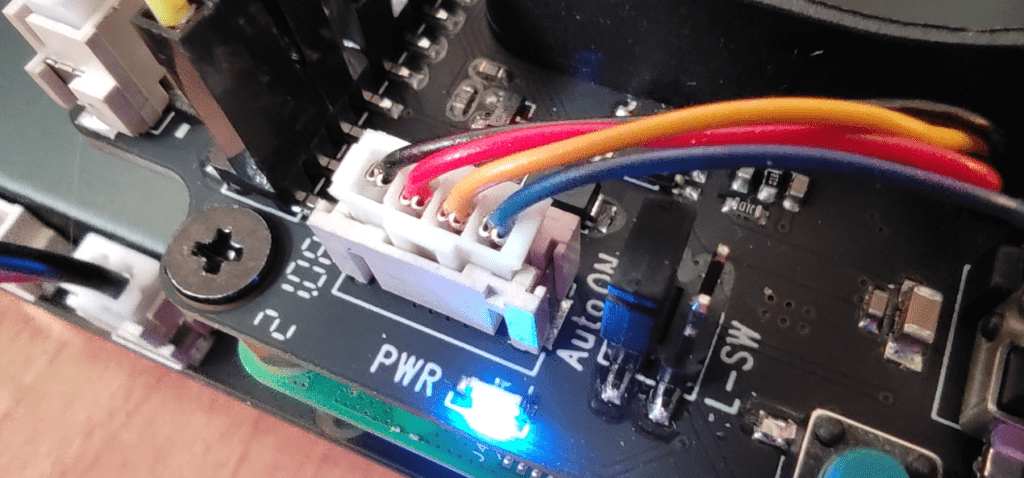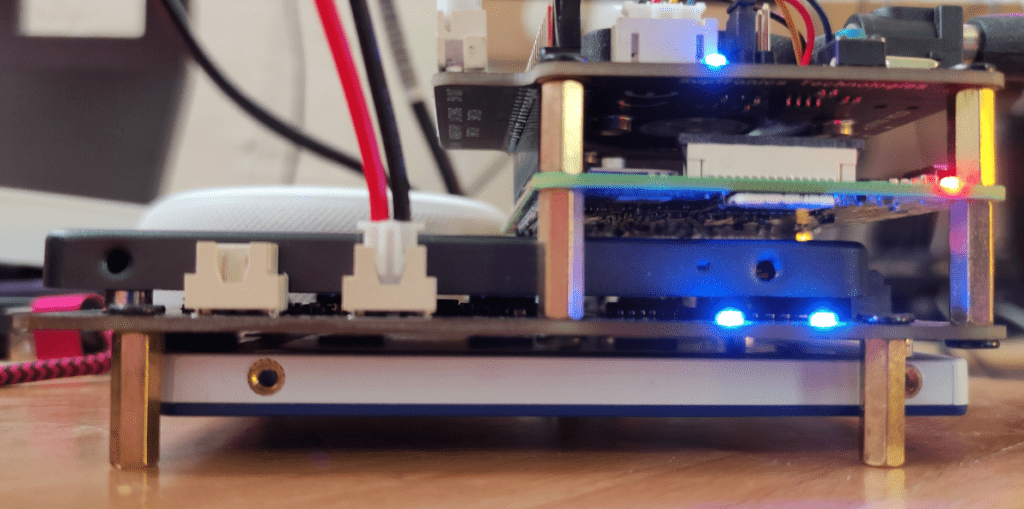Like other Raspberry Pi 4 owners I’ve been wrestling with which is the best power option – can I use 2 SSDs – how do I ensure which SSD will start first – what case to use and related questions – well, I’m at an interesting peak with this right now – apart from the case part of it.. anyway, here’s a photo – in the middle of that lot is my 2GB RPi4 running all my home control on an SSD drive as it has for months now… but now I’ve a backup drive on the same setup.
Having recently purchased a dual SATA board to fit UNDER my RPi4, I completed the setup with the purchaase of an X735 v2.5 “Power Management and PWM cooling Fan Expansion Board with Safe Shutdown” which sits on TOP of the RPi4. I have tried MANY different boards, cases and hats to achieve what I have here and despite having no case, this current setup appears to be the most functional. It requires a separate power supply – I have a plug-in-the-wall 5v 3A supply (not shown, boring) which as you’ll see plugs into the power board. T
he Pi is running at a reaonasble temperature (<45c processor) despite no heatsinks though I may still fit one if I can get something into the small space available. I’m running two SATA drives, one hopefully as a backup and up to now, the Pi appears to RELIABLY always start on the second SATA – I’ve been trying to clarify this for ages with the RPi without results but here we are. If a programmed SD is inserted, that will obviously take precidence.
None of this is of course cost-effective, RPi + PSU + these two boards takes you well past a second hand laptop:-) But it works, it is on 24-7 and I’m happy.
BUT if this PSU controller appeals you will need to know this: In order to have auto power up, you will need to insert a supplied link on the board. In addition, by default, the fan does not turn on. You need to grab some free software… I found the description here – but of course if AliExpress stop selling the product that link will go dead. SOO – there is a site called Raspberrypiwiki with a link to X735. Apparently Geekworm do a 5v 4A plug-in-the-wall supply. I noted that on Amazon.es, while also noting they are also selling the older v2.0 version of ths power board shown here.
The board handles safe power-off – but I have my RPi4 on a mains UPS to be sure. With this and the bottom dual SATA controller there is no longer a use for the RPI USB-C power input which has been problamatic in the past with dual SATA drives (some say the Pi power controller has issues – I just know I could not run 2 SATA SSDs without power glitches). This lot uses up RPi USB-C but the SATA board gave me two USB3 connectors for general use – overall gain, one USB 3, one USB-C and one micro-USB.
This is the AliExpress link for my SATA board, no guarantees the link will be valid when you read this – they also have a metal case but of course if you are using WiFi on your RPI, that’s probably not a good idea. I’m using Ethernet but the case isn’t very pretty anyway. Embedded black metal heatsinks I see on the above link will not fit in this scenario. Also the “specially made” USB jumper turned out to be an unreliable short USB lead. I binned it and bought a slightly longer USB-USB lead (male-to-male).




I’m building a custom photograph hosting site using Nodejs and express framework. I’m doing almost all the rendering server side so I can build a site with very few external dependencies. It’s mainly for family and friends so not too much traffic.
Currently hosting about 160,000 images.
I’m using and Odroid HC4 with Ubuntu 20.04. It supports 2 SATA drives and I have 2x 1TB installed. I have the primary site running fine and am using lsyncd to mirror the second in real time. So far it’s working great.
Here’s my ansible template for the lsyncd.conf.lua.j2 file:
settings {
logfile = “/var/log/lsyncd/lsyncd.log”,
statusFile = “/var/log/lsyncd/lsyncd.status”,
statusInterval = 20,
nodaemon = false
}
sync {
default.rsync,
source = “{{ arc_base_dir }}”,
target = “{{ arc_backup_dir }}”
}
The base_dir and backup_dir references are variables for the obvious directories.
I am developing the site and checking it into my local gitlab repo then deploying into the odroid and into a kvm server instance so I can test the difference in performance. The odroid is not as fast, but it’s quite reasonable.
Anyway, look at lsyncd. It’s more or less like rsync.
Always enjoy reading your reviews and project notes. Thanks.
Thanks!
Thanks Pete. With RPI-CLONE is it simply the case of kicking-off a backup task, or do you have to stop any of the services/background tasks first? I remember some debate about ‘live’ backups in the past, so just wondering how you handle that side of things now?
I have the X829 + X735 combo on order, and just thinking-through the best approach to getting them configured in the best possible way when they arrive.
Which out of the two is the boot drive in your setup, and do you use the same size drives for both?
I run my RPi2 headless so I’m running one or more SSH sessions on Mobaxterm on my PC (several other programs would do the same job)…
I simply start up a session, run one of my lazy macros for RPI-CLONE (cloneb makes a clone on SDB, cclone makes a clean clone on SDB) and leave the session open until it’s done. By clean clone I mean the rare time I have an SD or SSD that has not been used on the RPi before.
I don’t need to make the SSD or SD the same size – for my uses anything ABOVE 16GB will do the job, can’t QUITE get away with 16GB any more.
As it happens, the RPi seems to reliably start on SDB SDB assuming both SDA and SDB are attached – not that this was deliberate, I’ve never gotten to the bottom of that one… unless of course an SD is in there in which case it’ll boot off that. If anyone hsa a simple way to force booting off SDA when both SSDs are present, that could be useful to know.
Here’s my 2GB RPi4 with all three present.
Hi Pete, I know you’ve written a lot in the past about backing-up your Pi image/data, but can I ask what your current backup strategy/system is with this setup?
Thanks.
Not so much of a strategy…. i have my new board which takes 2 SSDs and reliably seems to start on the second one – so I RPI-CLONE to the first one at regular intervals (takes a couple of minutes only) and less regularly back up to SD using again RPI-CLONE… Just as well I do this as not that long ago when Node-Red updated I screwed the lt up irretrievably. Now I’m onto the latest NODEJS all is well but only because I had clones… I think I’d still prefer to have clones on a different PI with some method of fallover…. back in the UK my PI has gone down – I had someone try a backup SSD – the RPi lights come on – but it’s not connecting….. now it will have to wit till I get back to sort – I’ll take another RPi with me just in case – this has never happened before… (of course it could be the internal router which the Pi is connected to – but that’s never failed before, either.